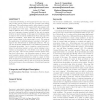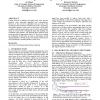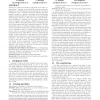KDD
2008
ACM
14 years 11 months ago
2008
ACM
Information diffusion, viral marketing, and collective classification all attempt to model and exploit the relationships in a network to make inferences about the labels of nodes....
KDD
2008
ACM
14 years 11 months ago
2008
ACM
The effectiveness of knowledge transfer using classification algorithms depends on the difference between the distribution that generates the training examples and the one from wh...
KDD
2008
ACM
14 years 11 months ago
2008
ACM
Low-rank approximations of the adjacency matrix of a graph are essential in finding patterns (such as communities) and detecting anomalies. Additionally, it is desirable to track ...
KDD
2008
ACM
14 years 11 months ago
2008
ACM
The input to an algorithm that learns a binary classifier normally consists of two sets of examples, where one set consists of positive examples of the concept to be learned, and ...
KDD
2008
ACM
14 years 11 months ago
2008
ACM
Contextual advertising on web pages has become very popular recently and it poses its own set of unique text mining challenges. Often advertisers wish to either target (or avoid) ...
KDD
2008
ACM
14 years 11 months ago
2008
ACM
Current research in indexing and mining time series data has produced many interesting algorithms and representations. However, it has not led to algorithms that can scale to the ...
KDD
2008
ACM
14 years 11 months ago
2008
ACM
Learning to rank from relevance judgment is an active research area. Itemwise score regression, pairwise preference satisfaction, and listwise structured learning are the major te...
KDD
2008
ACM
14 years 11 months ago
2008
ACM
Re-identification is a major privacy threat to public datasets containing individual records. Many privacy protection algorithms rely on generalization and suppression of "qu...
KDD
2008
ACM
14 years 11 months ago
2008
ACM
We introduce a new approach to analyzing click logs by examining both the documents that are clicked and those that are bypassed--documents returned higher in the ordering of the ...
KDD
2008
ACM
14 years 11 months ago
2008
ACM
There is an exploding amount of user-generated content on the Web due to the emergence of "Web 2.0" services, such as Blogger, MySpace, Flickr, and del.icio.us. The part...



